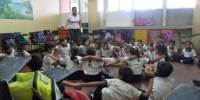Executive Summary
Regardless of the level of development achieved by the respective economies, women play a pivotal role in every sector and in rural development in Bangladesh. In developing countries, among the poor, rural women are the poorest and more vulnerable.
Projects aiming to reduce poverty view the poor rural women as the recipient of benefits of development, instead of active participant and still poor rural women have the least access to basic needs such as food, health and education.
Introduction
This report is conducted for developing rural women as an asset in our national economy. Some of the social, religious and economic factor hinders the activity of development of rural women.
Bangladesh is a developing country and there are huge labor force exist in our country. These labor resources are including both employed and unemployed labor force. In the case of unemployed the major part is consisted by women. In the situation of Bangladesh women are seemed to be less productive, energetic and have little impact in our economic growth, especially rural women. Economic adversity and living in insecurity are similar for major rural women. Rural women face discrimination in their everyday life. They are not permissible to go outside without security. There are not assessments of their activity like as household activity, small farming, cane etc. They also face gender inequality, lack of nutrition, illiteracy etc. Due to our socio-economic and religious perspective it is seemed to be that women are not equal with a man. But if we would like to develop our country in a position of developed country it is crucial that empowerment and economic security of rural women and also modify our rural policy. If we want to develop our economy with a sound GDP growth woman should be regarded as an asset. Rural women can be encouraged by small enterprise like as boutique industry, cane, small farming etc by providing micro credit program. Government and NGO’s can also play a vital role of implementing the rural women development program.
Justification
As a developing country Bangladesh always face illiteracy and poverty. The main victim of this problem is women especially rural women. We conduct this research for the development and sake of rural women. Especially rural women considered to be less productive, weak, fragile and can not possibly contribute to the national income. It is the general and traditional scenario of Bangladesh. In this research we try to focus on their present condition and why rural women development their empowerment is necessary.
We should like to conduct this typical research on the behalf of rural women for increase the social awareness. Now a simple question can be arise, why rural women? Why not urban women development? because in present time urban women are so fast with the age & generation and their average living standard is considerably high than the rural women. Other’s concern of this research is why rural women development and empowerment is necessary? What will be their contribution? What is their significance?
We try to prove that putting the rural women development last first, development of society, broadly country progress began faster and as a nation we can become stronger.
Objective of the Study
There is always at least an objective behind any work, which drives a person towards to work. As per natural rule we also have some objectives for completing this report. Objectives those drove us to completing this paper is to:
Primary Objective:
Put rural women last in first
Secondary objectives:
- How to remove Hunger and Poverty of rural women?
- How to remove Discrimination and Underdevelopment?
- How to ensure rural Women Food Security Issues?
- How to gender Equality and Sharing of Opportunities?
- How to rural Women in Agricultural Cooperatives?
- How to constraints faced by Farming rural Women?
- How to make Educated and Employed?
Methodology
For our research we have used social survey methodology.
Source of data:
Both primary and secondary sources are used while collecting information for the report.
@Primary Data:
Primary data has been collected by interviewing rural women. Information was collected through the discussion with rural women.
@ Secondary Data:
Sources of secondary data are as follows:
1 Internal Sources-
@ Informal interview
2 External sources-
@ Different books and periodicals related to our topic.
Research approach:
For our research paper, we will go to the village and ask relevant question to the rural women and will collect the data. We will also research the web site related to this topic of this research.
Research tools
@Questionnaire:
To collect data we will use a set of relevant questionnaire to ask the people to fill it up the questionnaire will be in MCQ type and open ended.
@Mechanical tools:
For our report we will use computer and its software like Microsoft word, excel and the internet for browsing for information.
Sampling plan:
@ Sample unit:
Sample is like selection. Like there is huge population but we are targeting some population as sample. In case of our report we sampled randomly.
@. Sample size:
We will take a small sample size for our data collection process through interview.
Contact method:
@ Personal interview:
We will mainly base on personal interview as contact method for collecting data for our term paper. We will give the questionnaire and ask to fill it up
Limitations
1) Time limit is very short
2) Lack of information
3) Lack of time to study more about this topic
Literature Review
Afrin, Sharmina; Nazrul Islam; and Shahid Uddin Ahmed (2008) They are completed a research topic was:“A Multivariate Model of Micro Credit and Rural Women Entrepreneurship Development in Bangladesh”.
The overview of this topic is females remain idle in their houses due to a number of social and cultural barriers. They are discouraged from working outside of their homes. This situation can be attributed to the dominant patriarchal society and strong religious influence in Bangladesh. Barriers can also be attributed to the lack of access to funds, the knowledge of agro-based production technology and the market, as well as the support from other family members. Research shows that a large number of rural women in Bangladesh are compelled by macroeconomic factors to enter into the labor market. Hence, the overwhelming majority of women in Bangladesh are poor and also caught between two vastly different worlds: the world determined by culture and tradition that confines their activities inside family homesteads, and the world shaped by increasing landlessness and poverty that drive them outside into wage employment. It also shows the impact of Micro credit on rural women development.
Faraha Nawaz Department of Public Administration, Rajshahi University also completed a research topic was:
“Critical Factors of Women Entrepreneurship Development in Rural Bangladesh”
The research paper aims to analyze the critical factors of women entrepreneurship development in rural Bangladesh. The analysis is based on recent theoretical ideas that have been supported by empirical research findings. The paper depicts an analytical framework based on institutional theory, which focuses on three kinds of factors: regulative, normative, and cognitive. Regulative factors refer to different rules and regulations of the Government that facilitate women entrepreneurship development in rural Bangladesh. Normative and cognitive factors include norms, rules, regulation, and values of society.
Based on the analysis of these factors, the paper provides many significant policy implications on how to improve women entrepreneurship development in rural Bangladesh.
From discoverybangladesh.com we found according to the rural women development:-
The government is trying hard to integrate the womenfolk of the country into the mainstream of the development process which is one of the main strategies for overall 50cm-economic development. Poverty, malnutrition, hunger, illiteracy, etc. are largely concentrated around womenfolk, and as such women can act as uniquely suitable agents for elimination of these socio-economic maladies. Attainment of reasonable growth rate, alleviation of poverty through generation of production employment opportunities and increased self-reliance are inextricably linked with increased participation of women in development efforts.
But in our research we try to find the projects aiming to reduce poverty view the poor rural women as the recipient of benefits of development, instead of active participant and still poor rural women have the least access to basic needs such as food, health and education.
Rural women condition
Previous condition:
Previously rural women had no rights to say something’s about their family matters . nowadays they have little bit contribution about decision making but this portion is relatively poor. Although in rural area male dominated behavior is also prevailing nowadays but it was intense in our previous stage. They seemed to be a tools of households activity, poor health condition exist because of regular child born and bearing.
Present Condition:
In the case of unemployed the major part is consisted by women. In the situation of Bangladesh women are seemed to be less productive, energetic and have little impact in our economic growth, especially rural women. Economic adversity and living in insecurity are similar for major rural women. Rural women face discrimination in their everyday life. They are not permissible to go outside without security. There are not assessment of their activity like as household activity, small farming, cane etc. They also face gender inequality, lack of nutrition ,illiteracy etc. Due to our socio-economic and religious perspective it is seemed to be that women are not equal with a man. Due to green revolution our rural women job has gone without replacement. 50 lakh rural poor women are unemployed.(because of rice mills). Rural women can’t glean paddy from field. In Bangladesh man are poor but women are poor and discriminated. rural women faces more poverty burden than man.
- Rural women eat after than man. If there will be no food they starve rather than man.
- Rural mother always face all problems of daughters in laws house.
- Boys go to school before than girls.
Rural women contribution in our home and country:
Women have made important contributions in almost every aspects of our society from the time immemorial. About half of the population of Bangladesh is women among them 45.6 percent are associated with the farming community. Historically the work of women in Bangladesh was not acceptable by the restriction of our culture, religion, and social restrictions. But now women are participate in the different economic activities outside their homestead. Currently, women in Bangladesh have an anchoring role in the management of their families as well as equal participation in different economic activities like crop production, post-harvest activities, poultry rearing, management of livestock and fisheries and miscellaneous income generating activities. Rural women’s participation in income generating activities is high because these households have higher number of family members in compare to lower number of capable male earning members. They are intimately involved in all phases of agricultural activities from sowing seeds to harvesting and processing of crops. They are also involved in different on agriculture activities like sewing dress, making baskets, making papers, flower vases, rearing of poultry, livestock and in different small scale business. Even women from the poorest households sometimes work outside the home as paid laborers for their family survival. Though, Bangladeshi women are playing very important role in both at home and outside but still disparities exist between men and women in education, health, employment and income opportunities, control over assets, personal security and participation in the political process. In reality, according toaccording to
prep.
1. As stated or indicated by; on the authority of: according to historians.
2. In keeping with: according to instructions.
3. Click the link for more information. the United Nations Gender-related Development Index (GDI (Graphics Device Interface) The traditional programming interface (API) for output in Windows. When an application needs to display or print, it makes a call to a GDI function and sends it the parameters for the object that must be created. ), Bangladesh ranked 105th out of 177 countries globally Therefore, Bangladeshi women are underprivileged and less empowered and this undeniably restricts the country’s ability to achieve its full potential.
Considering this reality our development partners and the donor agencies prescribed to involve the women in all sorts of activities for reducing gender inequalities and empowering them to achieve sustainable development Sustainable development is a socio-ecological process characterized by the fulfilment of human needs while maintaining the quality of the natural environment indefinitely. The linkage between environment and development was globally recognized in 1980, when the International Union . Thus the government has also included women empowerment issue in the Millennium Development Goal. In addition, for improving the empowerment of women a number of measures have been taken by the micro-credit NGOs like Grameen Bank (GB), Bangladesh Rural Advancement Committee (BRAC Brač (bräch), Ital. Brazza, island (1991 pop. 13,824), 152 sq mi (394 sq km), off the Dalmatian coast in the Adriatic Sea, Croatia. It is a popular summer resort and tourist spot. Supetar (Ital. ), PROSHIKA PROSHIKA Proshikkhan Shikkha Karmo (Training, Education, Action, Bangladesh) , Thengamara Mohila Sabuj Sangha sangha: see Buddhism.
sangha
Buddhist monastic order, traditionally composed of four groups: monks, nuns, laymen, and laywomen. Established by the Buddha, it is the world’s oldest body of celibate clerics. (TMSS TMSS Transportation Management Services Solution (US GSA)
TMSS Technical Manual Specifications & Standards (US DoD)
TMSS Trailer Mounted Support System (US DoD) ) and Rangpur Dinajpur Rural Service (RDRS RDRS Rangpur Dinajpur Rural Service (Bangladesh) ) etc. All these micro-credit NGOs are giving support to the deprived section of the society, especially women, in terms of employment, income earning to improve their status of livings through the services like small loans, education for their children, health and family planning family planning
Use of measures designed to regulate the number and spacing of children within a family, largely to curb population growth and ensure each family’s access to limited resources. care, sanitation sanitation: see plumbing; sanitary science. , legal support and various types of skill development training. Due to the direct and indirect support from these micro-credit NGOs now women are participate in various economic activities which eventually contribute in their household income.
Impact of rural women activity in our national economy:
The participation of rural women in the economic activity that is help to increase our national income this is also help to the their family to create standard of living by this they also ensure the good health and good education of their children. Introduction of modern technology which is effective to develop the activity of rural women .by this they can get extra time for doing more economic activity like as after doing the agricultural and household work besides this they can also involve in non agricultural work. Modern technology help the rural women but the introduction of modern technology 50 lakh rural women who using “deki” they loss their job . study from BIDS said that the value of total rice save by rural women in two districts is more than the national savings of Bangladesh.
NGOs Programme focus
Agricultural and rural development programmes in Bangladesh need to include the following areas of intervention in order to address both rural women’s and men’s priorities:
- train field staff in gender-sensitive and participatory planning and programme implementation that are culturally acceptable;
- support women’s work in farm and homestead production instead of merely viewing them as wives of male farmers;
- strengthen the extension system to be gender-equitable to ensure its effectiveness;
- identify and respond to women’s agricultural and household needs for technology in close collaboration with among researchers, implementing agencies and grassroots workers;
- support women in their home-based post-harvest production and marketing activities by providing local market information and linkages, improving transportation and storage facilities, improving processing and packaging techniques, enhancing credit facilities;
- launch adult literacy programmes and credit use capabilities with particular focus on women;
Government activity with rural women
The government is trying hard to integrate the rural women of the country into the mainstream of the development process which is one of the main strategies for overall 50cm-economic development. Poverty, malnutrition, hunger,illiteracy,etc.
1. The Department of Women’s Affairs with a countrywide network and Jatiya Mohila Sangstha – an organization with branches all over the country promote women’s rights, interests and soclo-economic opportunities. Appropriate laws have been framed, especially during the nineties, to stop repression and discrimination against women. The government reconstituted the National Women’s Development Council in January, 1997, to provide overall guidance on women’s development issues.
2. The majority of births in rural Bangladesh are carried out in unhygienic conditions by relatives and traditional birth attendants (TBAs). This results in a high incidence of maternal and infant mortality that could be reduced if childbirth were to occur in health centers or under the supervision of trained TBAs (TTBAs).
3. Bangladesh Government continued to explore the expansion of microcredit facilities with multi-disciplinary activities in rural areas of the country. Yet, the major challenges like different rate of interest, overlapping and absence of regulatory framework appeared as constraints. Besides, Government microcredit operators lack adequate capacities required to institutionalize the same. Microcredit programme in Government sector appeared to be expensive with limited growth opportunity and marketing facilities. In spite of the fact, Government sector achieved significant gains in using micro-finance to reach the poor and marginalized segments of the society in Bangladesh.
4. Historically, Government has taken endeavors to have access to credit to poor by enacting Land Improvement Act, Agricultural Loan Act, Money Lenders Act and Co-operative Societies Act. The Debt Settlement Board has helped the poor and marginal farmers from extinction. The Comilla Approach since sixties generated the spirit of self-help among villages. BRDB through its different projects has institutionalized the microcredit.
5. The success stories of few projects in the Government sector indicate remarkable achievements in income earning, empowerment of rural woman and creation of employment opportunities. Independent review suggests that Government programmes are helping in creating safety net for the poor, reducing risk and contributing in social capital development. Bangladesh Bank is encouraging to establish linkages by issuing guidelines and formulating a regulatory framework. A Cabinet Sub-committee headed by Hon’ble Finance & Planning Minister is also working for effective coordination and strengthening micro-finance activities.
In 1975, the BRDB launched a countrywide women’s development project titled, “Strengthening Population Planning through Rural Women’s Cooperatives”. The project sought to mobilize women in the development process by organizing them into cooperatives, which then granted members access to BRDB services. The success of the project led it to become established as a main scheme programme under the recurring revenue budget. Organize rural poor women into cooperatives for their participation in socio-economic development, Improve rural women’s socio-economic condition by equipping them with skills and knowledge,
Tangail Women’s Training Centre
It is an important and specialized women training centre of BRDB situated in Tangail which providing valuable support and services to rural women, The centre was built to provide advanced training to women co-operators, which could not be administered at the Upazila level. The centre trains society representatives, who then return to their villages and train their fellow co-operators. To date, the centre has provided training to over 9000 members.
Mahila Bittaheen Kendrio Unnayan Samity (MOBIKUS)
This programme aims to reduce poverty of the distressed women and empowered them socio-economically through providing skill development training and micro-credit for income generating activities. This programme is implemented in 20 Upazilas within Dhaka, Manikgonj, Munshigonj, Narayangonj, Gazipur and Narsingdi Districts.
Self Employment Project for the Poor Women (DAMAK)
This project aims to alleviate poverty, raise the standard of living and empower them socio – economically of the distressed women. The project operates in 21 Upazilas in the greater Jessore District.
Recommendations & Conclusion:
Here our objective is to put rural women last fast so we give some suggestions that how we can put rural women last fast-
- Rural women can be developed by encouraging crafts industry, pottery, flute industry (bamboo craft), sheetolpathi, Nakshi-kantha, jamdani, cane industry, wood, Brass industry, shell, jute, paper craft, candle industry etc
- If gov. give more emphasis to encourage rural women to do such types of activity to reduce their unemployment I think our national GDP will be increases.
- Gov. should give priority to availability of raw materials used in these types of industry and also create awareness and market for these industry which are already seemed to be primitive by society.
- Our Bangladeshi scientist Dr. Maksudur rahman recently invented the genetic secret of jute. So it is great opportunity for our country to develop our old jute industry. I think besides of man rural women can be contributed to turn back jutes golden day.
















